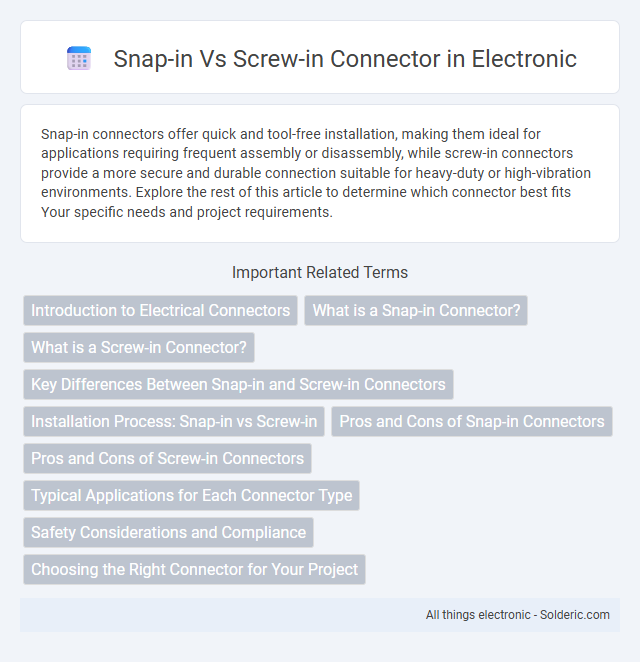Snap-in connectors offer quick and tool-free installation, making them ideal for applications requiring frequent assembly or disassembly, while screw-in connectors provide a more secure and durable connection suitable for heavy-duty or high-vibration environments. Explore the rest of this article to determine which connector best fits Your specific needs and project requirements.
Comparison Table
| Feature | Snap-in Connector | Screw-in Connector |
|---|---|---|
| Installation | Quick, tool-free snap mechanism | Requires screwdriver to fasten screws |
| Connection Type | Locking clips hold wires securely | Screws tighten to clamp wires firmly |
| Application | Ideal for quick assembly and maintenance | Preferred for durable and stable connections |
| Durability | Moderate, may loosen over time | High, resists vibration and loosening |
| Reusability | Limited; clips can wear out | High; screws can be tightened multiple times |
| Cost | Generally lower cost | Typically higher cost due to hardware |
| Common Usage | Electronics, light fixtures | Electrical wiring, industrial equipment |
Introduction to Electrical Connectors
Snap-in and screw-in connectors are essential components in electrical systems, providing secure and reliable connections between wires and devices. Snap-in connectors offer quick installation with a friction-lock mechanism, ideal for rapid assembly and maintenance, while screw-in connectors provide a more durable, adjustable connection through threaded terminals, often preferred in high-vibration environments. Selecting the appropriate connector depends on factors such as installation speed, mechanical stability, and application-specific requirements in electrical circuits.
What is a Snap-in Connector?
A snap-in connector is a type of electrical connector designed for quick and easy installation by simply snapping it into place without the need for additional tools or screws. This connector ensures secure and reliable connections in panels or enclosures, reducing assembly time and improving workflow efficiency. Your choice of snap-in connectors can optimize maintenance by allowing fast replacements and minimizing downtime in electronic systems.
What is a Screw-in Connector?
A screw-in connector is an electrical device designed to securely join wires by twisting them around a threaded metal post and tightening with a screw mechanism. Commonly used in residential and commercial wiring, this connector ensures a stable and durable connection that resists loosening from vibrations or movement. Compared to snap-in connectors, screw-in types provide a more robust and reliable electrical contact, making them ideal for high-current or long-term applications.
Key Differences Between Snap-in and Screw-in Connectors
Snap-in connectors offer quick and easy installation by simply snapping into place, making them ideal for applications requiring fast assembly without tools. Screw-in connectors provide a more secure and durable connection through threaded fastening, ensuring enhanced mechanical stability and resistance to vibrations. Your choice between snap-in and screw-in connectors should consider factors like installation speed, mechanical reliability, and the specific requirements of your electrical or mechanical system.
Installation Process: Snap-in vs Screw-in
Snap-in connectors offer a tool-free, quick installation process, enabling you to securely lock components with a simple push, making them ideal for applications requiring frequent assembly or disassembly. Screw-in connectors require precise alignment and manual tightening with tools, ensuring a more rigid and vibration-resistant connection suitable for heavy-duty or high-stress environments. Choosing between snap-in and screw-in depends on the balance between ease of installation and the need for mechanical stability in your project.
Pros and Cons of Snap-in Connectors
Snap-in connectors offer quick installation and secure fastening without the need for tools, reducing assembly time and labor costs. However, they may lack the same mechanical strength and long-term reliability as screw-in connectors, especially in high-vibration environments. Snap-in connectors are ideal for applications requiring frequent disconnection or lightweight assembly but are less suitable for heavy-duty or high-load connections.
Pros and Cons of Screw-in Connectors
Screw-in connectors provide a secure and reliable electrical connection ideal for heavy-duty wiring applications, offering exceptional resistance to vibration and loosening over time. Their main drawback lies in the longer installation process compared to snap-in connectors, requiring precise tightening to ensure safety and optimal performance. Your choice might favor screw-in connectors when prioritizing durability and strong mechanical hold in demanding environments.
Typical Applications for Each Connector Type
Snap-in connectors are commonly used in low-voltage LED lighting fixtures, providing quick and tool-free installation in residential and commercial environments. Screw-in connectors are preferred in industrial and high-power electrical systems where secure, vibration-resistant connections are essential for motors, control panels, and heavy machinery. Each connector type suits specific applications based on installation speed and connection reliability requirements.
Safety Considerations and Compliance
Snap-in connectors offer quick installation but may pose risks if not securely fastened, potentially leading to loose connections and electrical hazards. Screw-in connectors provide a more reliable and secure connection, enhancing safety by minimizing the risk of arcing and electrical faults, which aligns better with strict compliance standards such as UL and NEC. Ensuring Your electrical setup uses screw-in connectors contributes to safer, code-compliant installations that reduce the risk of fire and equipment damage.
Choosing the Right Connector for Your Project
Choosing the right connector for your project depends on factors such as ease of installation, vibration resistance, and maintenance requirements. Snap-in connectors provide quick, tool-free assembly ideal for applications needing frequent disconnections, while screw-in connectors offer a secure, vibration-resistant connection suited for permanent or high-stress environments. Evaluating the specific demands of your project ensures optimal performance and reliability with the chosen connector type.
Snap-in vs Screw-in connector Infographic

 solderic.com
solderic.com